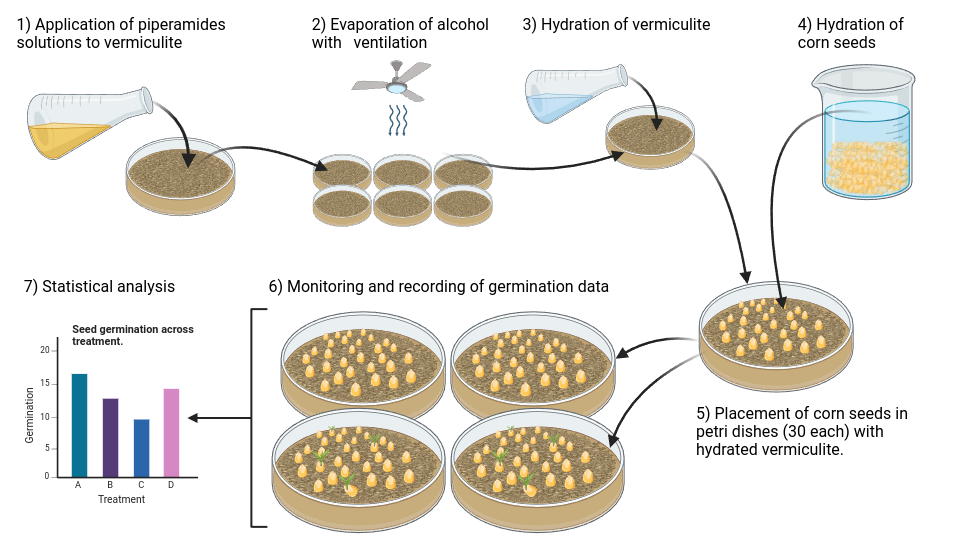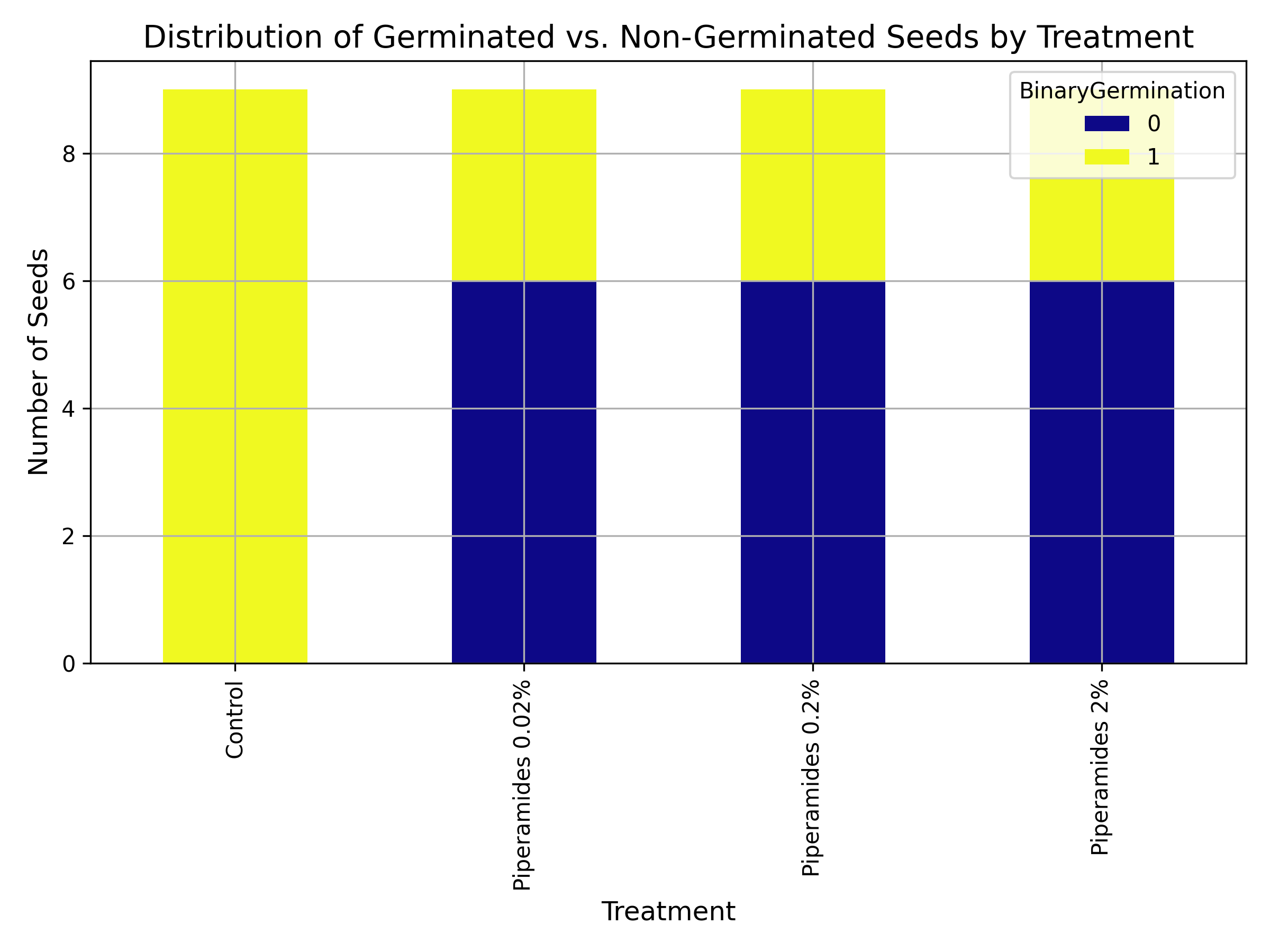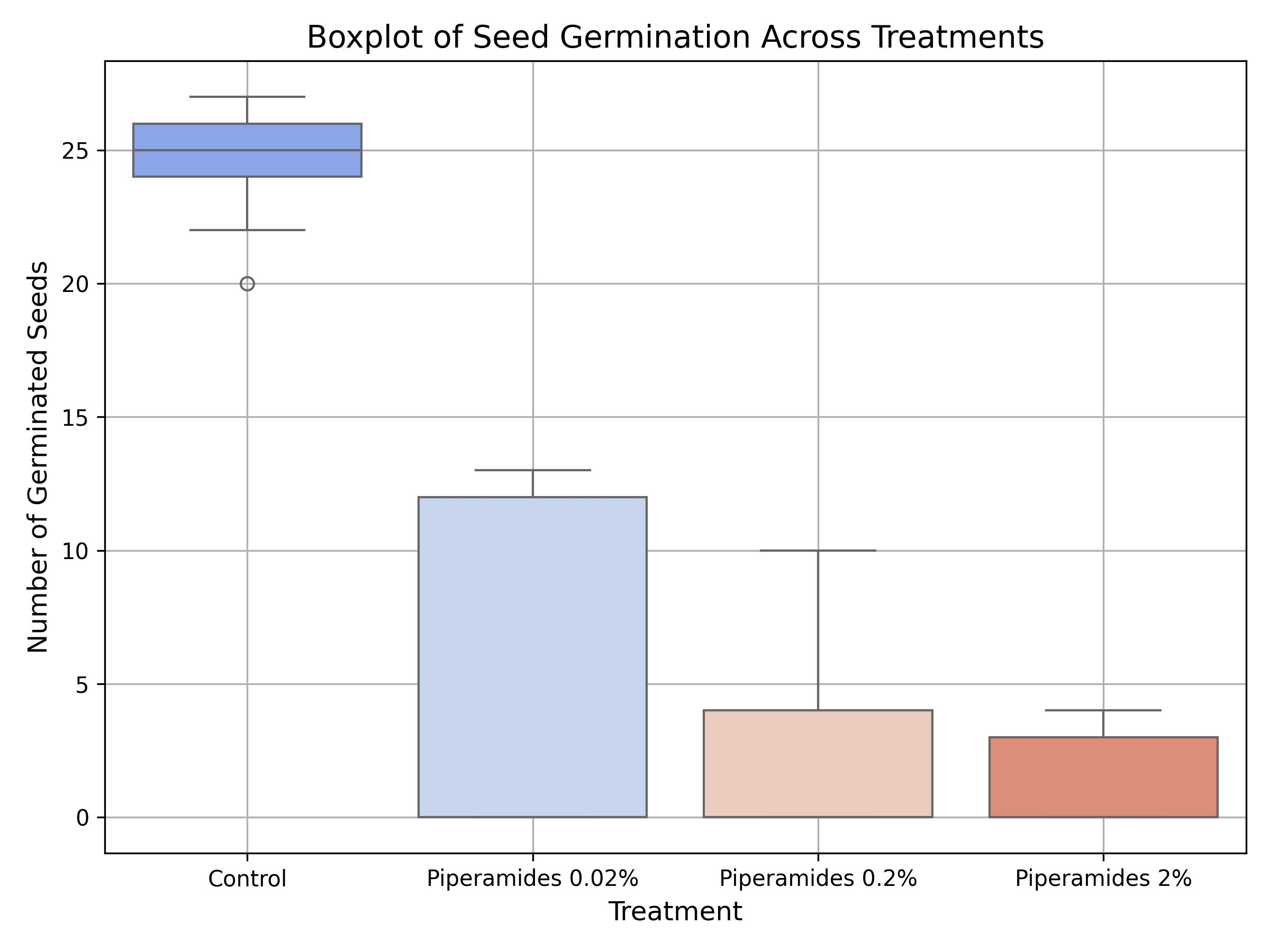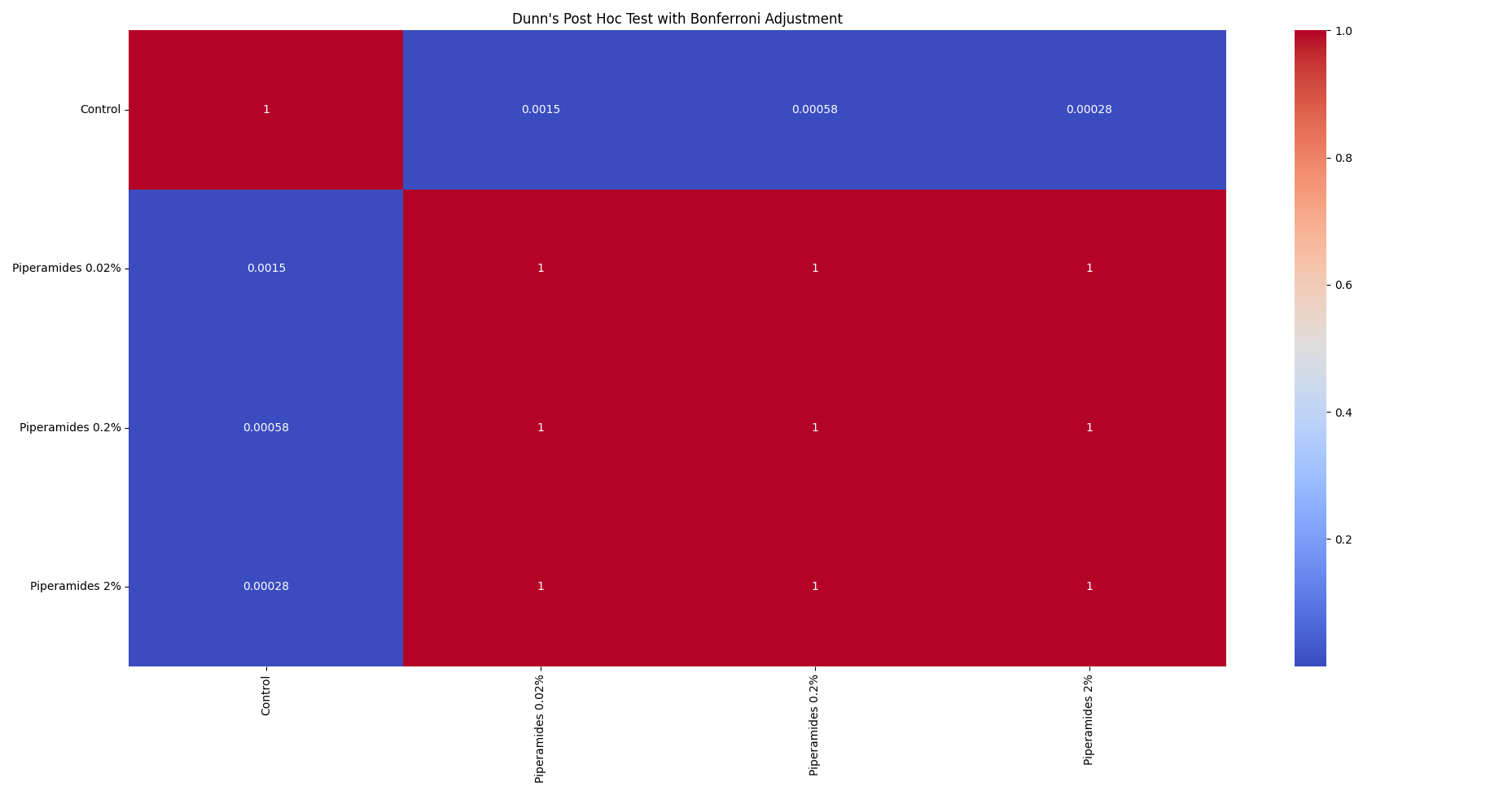Phytotoxicity Study on Maize
Introduction
The fall armyworm (Spodoptera frugiperda) poses a significant threat to maize (Zea mays) crops worldwide, leading to substantial economic losses. Sustainable agriculture necessitates the development of effective and environmentally friendly pest control methods. Piperamides, naturally occurring compounds found in Piper species, have emerged as promising candidates for biopesticide development due to their insecticidal and allelopathic properties.
Previous research has highlighted the selective phytotoxic effects of piperamides on various plant species. Tavares et al. (2011) investigated the inhibitory activity of piperine—a type of piperamide—on seed germination and seedling growth in both monocotyledonous and dicotyledonous plants. Their findings revealed a concentration-dependent effect: piperine inhibited germination in dicotyledons such as Bidens pilosa, Cucumis sativus, and Lactuca sativaby up to 12.82% at 5 mg/kg, while stimulating germination in the monocotyledonous Allium cepa by 30.43% at the same concentration. Additionally, piperine significantly reduced the seedling length in dicotyledons, suggesting its potential utility in organic weed management due to its selective allelopathic activity.
Given these selective effects, it is crucial to assess whether piperamides adversely affect maize—a monocotyledon—when used as a biopesticide against the fall armyworm. Understanding the impact of piperamides on maize seed germination and seedling growth is essential to ensure their safe application in maize cultivation. Specifically, we aim to evaluate the effects of piperamides present in the substrate on the germination and growth of maize seeds under controlled conditions (Mendes et al., 2021), simulating realistic field scenarios where the biopesticide would be applied via crop spraying.
To address this, we investigated three concentrations of piperamides (0.02%, 0.2%, and 2%) applied directly to the substrate. These concentrations were selected based on preliminary explorations with the aim of a biopesticide formulation with a concentration around 2%. By assessing the phytotoxic effects of piperamides at these concentrations, we seek to determine whether piperamide-based biopesticides can be safely used in maize fields without hindering seed germination and seedling development.
Our study provides valuable insights for the development of effective and safe piperamide-based biopesticides, balancing pest control efficacy with crop safety. The findings will inform strategies for the use of piperamides in maize cultivation, ensuring that the benefits of controlling the fall armyworm do not compromise crop viability.
To address this, we investigated three concentrations of piperamides (0.02%, 0.2%, and 2%) applied directly to the substrate. These concentrations were selected based on preliminary explorations with the aim of a biopesticide formulation with a concentration around 2%. By assessing the phytotoxic effects of piperamides at these concentrations, we sought to determine whether piperamide-based biopesticides can be safely used in maize fields without hindering seed germination and seedling development.
Our study provides valuable information for the development of effective and safe piperamide-based biopesticides, balancing pest control efficacy with crop safety. The findings will inform strategies for the use of piperamides in maize cultivation, ensuring that the benefits of controlling the fall armyworm do not compromise crop viability.
Methods
Figure 1. Experimental setup for evaluating the effects of piperamides on seed germination.
Piperamide solutions at different concentrations were applied to vermiculite, which was then left to dry for three days under direct ventilation. Once dried, the vermiculite was hydrated with water, and pre-hydrated maize seeds were placed on the treated substrate in Petri dishes. Seed germination was monitored on day 1, day 4, and day 7 after placement. Germination results were compared among the different treatments, as illustrated in the results section.

Figure 1: Experimental setup for evaluating the effects of piperamides on seed germination.
Preparation and Application of Treatments to the Substrate
Piperamide treatments were prepared by diluting a stock solution of piperamides at 10% to create three solutions corresponding to the concentrations used in each treatment (Table 1). For each treatment, 25 mL of the appropriate piperamide solution was taken and mixed thoroughly with 30 grams of vermiculite in a container. The mixture was agitated to ensure even distribution of the solution throughout the substrate. The treated vermiculite was then left uncovered in a dark, well-ventilated area for three days to allow the alcohol from the solutions to evaporate completely.
Treatment Description:
| Treatment | Description | Estimated Piperamides Concentration in Substrate (g/kg)* |
|---|---|---|
| Control | Deionized water | 0 |
| PS-1 | Piperamides 0.02% in absolute ethanol | 0.02 |
| PS-2 | Piperamides 0.2% in absolute ethanol | 0.2 |
| PS-3 | Piperamides 2% in absolute ethanol | 2 |
*Considering the increase in weight and volume due to vermiculite hydration.
Preparation of Maize Seeds
The maize seeds were purchased from a local supermarket, distributed by the brand Verde Valle, and specifically of the “Maíz Palomero” variety. The seeds were first washed with plain water and then placed in a beaker filled with water for hydration. The seeds were left to soak for 24 hours to promote germination and ensure uniform hydration (at least initially) across all experimental groups.
Seed Distribution, Incubation and Monitoring
For each treatment, 90 maize seeds were distributed across three Petri dishes containing the treated vermiculite. The dishes were then placed in an incubator set to a temperature of 25°C with a 12-hour light/12-hour dark photoperiod. Monitoring of germination was conducted on days 1, 4, and 7 after the seeds were placed in the Petri dishes. During each monitoring period, the number of germinated seeds in each Petri dish was counted individually.
Statistical Analysis
Data obtained from seed germination monitoring on days 1, 4, and 7 were analyzed to determine the effects of piperamide treatments on maize seed germination. Normality of the germination data was assessed using the Shapiro-Wilk test, while homoscedasticity was evaluated with Levene's test. Given the absence of normality or homoscedasticity in some datasets, non-parametric statistical tests were applied. The Kruskal-Wallis test was used to compare germination rates across treatments, followed by Dunn's post hoc test with Bonferroni correction to identify pairwise differences between groups. Additionally, a repeated-measures analysis of variance (ANOVA) was conducted to evaluate the effect of time (days) on germination rates across treatments. All statistical analyses were performed using Python, with a significance threshold set at p < 0.05. Graphical representations of the data, including boxplots, bar plots, and heatmaps, were generated to visualize differences between treatments.
Results
Figure 2. Distribution of germinated vs. non-germinated seeds by treatment.
This barplot shows the distribution of germinated (yellow) and non-germinated (blue) seeds for the control and different concentrations of piperamides (0.02%, 0.2%, and 2%). The control group exhibits a higher proportion of germinated seeds, while the piperamide treatments show a progressive reduction in germination across all concentrations. This indicates a clear inhibitory effect of piperamides on seed germination, with a larger portion of non-germinated seeds as piperamide concentration increases.

Figure 2: Distribution of germinated vs. non-germinated seeds by treatment.
Figure 3. Boxplot of seed germination across treatments.
This plot compares the number of germinated seeds after treatment with different concentrations of piperamides (0.02%, 0.2%, y 2%) versus the control. The control group shows a significantly higher number of germinated seeds compared to the piperamide treatments, which exhibit reduced germination in a dose-dependent manner. The boxes represent the interquartile range (IQR), the horizontal lines inside the boxes indican el mediano, y los bigotes muestran el rango de valores sin outliers. Los outliers están representados por puntos individuales.

Figure 3: Boxplot of seed germination across treatments.
Figure 4. Dunn's post hoc test with Bonferroni adjustment for multiple comparisons of seed germination between treatments.
The heatmap displays p-values for pairwise comparisons between the Control and Piperamides treatments (0.02%, 0.2%, y 2%) after a Kruskal-Wallis test. Blue cells indicate statistically significant differences (p < 0.05), mientras que las celdas rojas indican diferencias no significativas. Los resultados muestran diferencias significativas entre el Control y todos los tratamientos de Piperamides, pero no hay diferencias significativas entre las concentraciones de Piperamides (0.02%, 0.2%, y 2%).

Figure 4: Dunn's post hoc test with Bonferroni adjustment for multiple comparisons of seed germination between treatments.
Discussion
The primary objective of this study was to evaluate the phytotoxic effects of piperamides on maize (Zea mays) seed germination and seedling development to determine their suitability as biopesticides in maize cultivation. We investigated three concentrations of piperamides (0.02%, 0.2%, y 2%) applied directly to the substrate and compared their effects to a control group without piperamides. Our findings demonstrate a clear inhibitory effect of piperamides on maize seed germination, which intensified with increasing concentrations. This dose-dependent inhibition aligns with previous reports of piperamide phytotoxicity on dicotyledonous species but reveals a concerning sensitivity in maize, a monocotyledon.
The germination assays indicated that the control group exhibited significantly higher germination rates compared to all piperamide-treated groups (Figure 3). Even at the lowest concentration of 0.02%, piperamides significantly reduced germination rates, suggesting that maize seeds are highly sensitive to these compounds. The inhibitory effect was most pronounced at the highest concentration of 2%, where germination rates were drastically reduced. This dose-dependent response is consistent with the findings of Tavares et al. (2011), who reported that piperine inhibited germination in dicotyledonous plants at higher concentrations. However, unlike the monocot Allium cepa, which showed stimulated germination in the presence of piperine, maize seeds exhibited inhibition, indicating species-specific responses among monocots to piperamides.
Statistical analysis using the Kruskal-Wallis test confirmed significant differences between the control and all piperamide treatments (p < 0.05), as further supported by Dunn's post hoc test with Bonferroni correction (Figure 4). Notably, there were no significant differences among the piperamide treatments themselves, implying that even minimal concentrations can substantially inhibit maize seed germination. This lack of significant difference between varying concentrations suggests a threshold effect, where any presence of piperamides above a minimal level adversely affects germination.
The distribution analysis of germinated versus non-germinated seeds (Figure 2) reinforced this observation, showing an increased proportion of non-germinated seeds with higher piperamide concentrations. This trend indicates that the application of piperamide-based biopesticides could potentially compromise maize crop viability if not carefully managed. The sensitivity of maize seeds to piperamides raises concerns about their direct application to the substrate in agricultural settings.
Our findings highlight a critical consideration for the use of piperamides as biopesticides in maize cultivation. While piperamides are known for their insecticidal properties against pests like the fall armyworm (Spodoptera frugiperda), their phytotoxic effects on maize seeds present a significant obstacle. The contrasting responses between maize y otros monocotiledóneos como Allium cepa sugieren que la fitotoxicidad de los piperamides no es uniforme en las especies monocotiledóneas. Esta discrepancia subraya la importancia de evaluaciones fitotóxicas específicas para cada cultivo al desarrollar biopesticidas.
Several factors could contribute to the observed phytotoxicity in maize seeds. Piperamides may interfere with crucial physiological processes during germination, such as enzyme activity, hormonal regulation, or membrane integrity. The high lipophilicity of piperamides might facilitate their penetration into seed tissues, leading to intracellular disruptions that inhibit germination. Further research is needed to elucidate the exact mechanisms by which piperamides affect maize seeds.
Given the adverse effects observed even at the lowest concentration tested, alternative strategies must be considered to mitigate the phytotoxic impact of piperamides on maize. Possible approaches include:
- Formulation Adjustments: Developing controlled-release formulations or encapsulation techniques that reduce direct exposure of seeds to piperamides, potentially by targeting the active compound more precisely at the pest.
- Application Timing: Applying piperamide-based biopesticides at stages when maize seeds have already germinated and seedlings have developed past the most vulnerable stages.
- Combination with Safeners: Investigating the use of safener compounds that could protect maize seeds from the phytotoxic effects of piperamides without diminishing their insecticidal efficacy.
Our study also highlights the need for comprehensive risk assessments when introducing new biopesticides into agricultural practices. While the goal is to develop effective pest control methods that are environmentally friendly, it is crucial to ensure that these methods do not inadvertently harm the crops they are intended to protect. The balance between pest control efficacy and crop safety must be carefully managed.
Conclusion
In conclusion, although piperamides exhibit promising insecticidal properties against pests like the fall armyworm, their inhibitory effects on maize seed germination present significant challenges for their use in maize cultivation. Our findings suggest that direct application of piperamides to the substrate is not advisable due to the high sensitivity of maize seeds. Future research should focus on developing application methods that minimize phytotoxicity, understanding the mechanisms underlying the inhibitory effects, and evaluating the performance of piperamide-based biopesticides under realistic agricultural conditions. By addressing these challenges, it may be possible to harness the benefits of piperamides for pest control while ensuring the safety and viability of maize crops in sustainable agriculture.
References
- Tavares, W. S., Cruz, I., Petacci, F., Freitas, S. S., Serratilde, J. E., & Zanuncio, J. C. (2011). Insecticide activity of piperine: Toxicity to eggs of Spodoptera frugiperda (Lepidoptera: Noctuidae) y Diatraea saccharalis (Lepidoptera: Pyralidae) y fitotoxicidad en varias hortalizas. Journal Of Medicinal Plants Research, 5(21), 5301-5306. https://doi.org/10.5897/jmpr.9000814
- Mendes, P. M., Ribeiro, J. A., Martins, G. A., Lucia Jr, T., Araujo, T. R., Fuentes-Guevara, M. D., ... & Corrêa, É. K. (2021). Phytotoxicity test in check: Proposition of methodology for comparison of different method adaptations usually used worldwide. Journal of Environmental Management, 291, 112698.
- Nelson, D. L., Lehninger, A. L., & Cox, M. M. (2008). Lehninger principles of biochemistry. Macmillan.